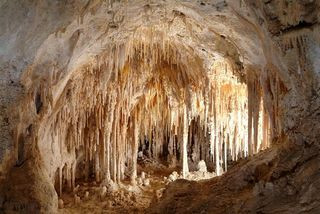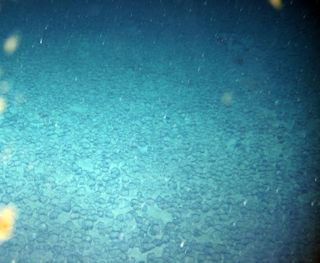Can You Grow Rocks? Yes, rocks can grow, increasing in size, mass, and strength over time through various natural processes. Let’s explore how rocks grow, the different types of rock growth, and how you can incorporate these fascinating geological formations into your landscaping projects with rockscapes.net.
1. What Exactly is a Rock?
Before diving into the mechanics of rock growth, it’s crucial to understand what defines a rock.
A rock is an aggregate of one or more minerals. Minerals themselves are naturally occurring, inorganic solids with a defined chemical composition and crystalline structure. Elements like silicon, oxygen, and carbon are the building blocks of minerals. According to John Brady, a professor of geology at Smith College, a rock forms when multiple mineral crystals come together, whether they are of the same type or different.
2. How Do Rocks Grow Taller and Larger?
Rocks can indeed grow taller and larger, although the process is much slower than the growth of living organisms.
Think of children growing taller and heavier each year. Rocks undergo a similar process, becoming bigger, heavier, and stronger, but it takes thousands or even millions of years for these changes to become noticeable.
2.1. Cave Formations: Stalactites and Stalagmites
One of the most visually striking examples of rock growth occurs in caves. As Cory BlackEagle, a geologist at the University of Kentucky, explains, water flowing along cave walls or dripping from the ceiling deposits minerals. These minerals, such as calcite, aragonite, opal, and chalcedony, accumulate over time. This leads to the formation of stalactites (hanging from the ceiling) and stalagmites (rising from the floor). Carlsbad Caverns National Park is famous for its soda straw stalactites and columns, showcasing this slow but steady growth.
 Soda straw stalactites and columns in Carlsbad Caverns National Park, illustrating the growth of cave rocks through mineral deposition from dripping water
Soda straw stalactites and columns in Carlsbad Caverns National Park, illustrating the growth of cave rocks through mineral deposition from dripping water
2.2. Travertine Growth at Hot Springs
Another example of rock growth can be observed at hot springs, where water flowing from underground onto the surface leads to the formation of travertine. Warmer water holds more dissolved minerals than cooler water, facilitating the deposition of these minerals as the water cools and evaporates. Mammoth Hot Springs in Yellowstone National Park is a prime example, with travertine deposits reaching 239 feet (73 meters) thick and covering over 1.5 square miles (4 square kilometers) in just 8,000 years.
3. How Do Rocks Grow Through Precipitation?
Rocks can also grow through a process called precipitation, where dissolved metals in water come out of solution and form solid deposits.
Water contains dissolved metals, which can “precipitate” out of seawater or freshwater, leading to rock growth. These rocks are known as concretions or nodules.
3.1. Manganese Nodules in the Ocean
Manganese, iron, copper, nickel, and cobalt concretions are commonly found on the ocean floor. These nodules grow layer by layer, much like a pearl. Interestingly, pearls are technically rocks, despite being created by oysters. Each layer adds to the nodule’s size, albeit very slowly. Manganese nodules, for example, grow at a rate of less than 0.3 inches (1 centimeter) every million years. This slow growth means that some of the largest concretions can be up to 10 million years old.
 Manganese nodules on the ocean floor, demonstrating rock growth through the precipitation of dissolved metals from seawater
Manganese nodules on the ocean floor, demonstrating rock growth through the precipitation of dissolved metals from seawater
3.2. Metal Concretions in Freshwater
Metal concretions can also form in freshwater environments. This usually occurs when water flows through rocks, leaving behind deposits of metallic minerals. The Moqui Marbles of the American Southwest are a notable example of this process. Interestingly, metal concretions have even been found on Mars, indicating that similar geological processes can occur on other planets.
 Microscopic sphere-like grains, or "blueberries," found on Mars, illustrating metal concretion in extraterrestrial environments
Microscopic sphere-like grains, or "blueberries," found on Mars, illustrating metal concretion in extraterrestrial environments
4. How Do Rocks Grow Stronger and Heavier Through Metamorphism?
Metamorphic rocks undergo transformations that can make them stronger and heavier.
Metamorphic rocks, one of the three main types of rocks (along with igneous and sedimentary rocks), are formed when existing rocks are subjected to heat, pressure, or both. The minerals in the original rock undergo changes, and sometimes new minerals are formed. The increased heat and pressure cause the minerals to lock more tightly together, resulting in increased strength. Additionally, the rock’s density may increase as the same amount of material is packed into a smaller volume. This makes a piece of metamorphic rock feel heavier than a piece of the original rock of the same size.
5. Why Does My Garden “Grow” Rocks?
Many gardeners find that rocks seem to reappear in their gardens each year, even after they have been removed.
The phenomenon of gardens seemingly “growing” rocks is due to a combination of factors that push rocks up from beneath the earth. These factors include frost heaving (the upward swelling of soil due to freezing), slow erosion, and soil turnover. Over time, these processes churn the soil, pushing rocks buried underground to the surface.
6. Incorporating Rock Growth Principles into Landscaping
Understanding how rocks grow can provide valuable insights for landscaping projects. Using different types of rocks, knowing their properties, and appreciating how they form can help you create stunning and sustainable landscapes. Visit rockscapes.net for inspiration and resources on incorporating natural stone into your outdoor spaces.
7. Rock Types and Their Applications in Landscaping
Different types of rocks offer unique aesthetics and functional benefits for landscaping. Here’s a table highlighting some common rock types and their applications:
| Rock Type | Description | Landscaping Applications |
|---|---|---|
| Granite | Hard, durable, and comes in various colors. | Retaining walls, pathways, accent stones, and water features. |
| Slate | Fine-grained and layered, often used for paving. | Patios, walkways, stepping stones, and decorative mulch. |
| Limestone | Sedimentary rock, often light in color and relatively soft. | Garden borders, pathways, and decorative elements. |
| Sandstone | Composed of sand grains, offering a natural and rustic look. | Walls, paving, and rock gardens. |
| River Rock | Smooth, rounded stones, typically found near rivers and streams. | Drainage, ground cover, and decorative accents in ponds and water features. |
| Lava Rock | Porous and lightweight, often used in arid landscaping. | Mulch, ground cover, and decorative accents in desert-themed gardens. |
| Fieldstone | Naturally occurring stones found on the ground surface. | Walls, borders, and rustic pathways. |
| Flagstone | Flat, thin slabs of rock, ideal for paving. | Patios, walkways, and stepping stones. |
| Boulders | Large, imposing rocks that can serve as focal points. | Accent features, natural seating, and retaining walls. |
| Crushed Stone | Angular fragments of rock, used for drainage and pathways. | Base material for patios and pathways, and as a decorative ground cover. |
| Cobblestone | Small, rounded stones, often used for paving and borders. | Driveways, pathways, and garden borders. |
| Pea Gravel | Small, rounded gravel, used for pathways and ground cover. | Pathways, play areas, and as a decorative ground cover. |
8. Design Ideas for Rock Landscaping
Rock landscaping offers endless possibilities for creating unique and beautiful outdoor spaces. Here are some design ideas to inspire your next project:
8.1. Rock Gardens
Create a rock garden featuring a variety of rock types, sizes, and textures. Incorporate drought-tolerant plants and succulents to complement the rocks and create a low-maintenance landscape.
8.2. Water Features
Use rocks to create natural-looking waterfalls, ponds, and streams. The sound of water cascading over rocks can add a sense of tranquility to your outdoor space.
8.3. Pathways and Walkways
Construct pathways and walkways using flagstone, slate, or river rock. These materials provide a durable and aesthetically pleasing surface for walking.
8.4. Retaining Walls
Build retaining walls using large boulders or stacked stones. These walls can help prevent soil erosion and create terraced garden beds.
8.5. Decorative Mulch
Use crushed stone or lava rock as a decorative mulch around plants. This can help retain moisture, suppress weeds, and add visual interest to your garden.
8.6. Accent Features
Place large boulders or interesting rock formations as accent features in your landscape. These can serve as focal points and add a touch of natural beauty to your outdoor space.
8.7. Zen Gardens
Create a Zen garden featuring carefully arranged rocks, sand, and minimalist plantings. This type of garden promotes relaxation and contemplation.
9. Finding the Right Rocks for Your Project
Selecting the right rocks for your landscaping project is essential for achieving the desired look and functionality. Consider the following factors when choosing rocks:
- Color and Texture: Choose rocks that complement the color and style of your home and garden.
- Size and Shape: Select rocks that are appropriate for the intended use and scale of your landscape.
- Durability: Opt for durable rocks that can withstand the elements and heavy foot traffic.
- Availability and Cost: Check the availability and cost of different rock types in your area.
Rockscapes.net offers a wide selection of high-quality rocks and stones for all your landscaping needs. Visit our website to explore our product catalog and find the perfect rocks for your project.
10. How to Maintain Your Rock Landscape
Maintaining your rock landscape is relatively easy, but regular care is essential for keeping it looking its best. Here are some tips for maintaining your rock landscape:
- Remove Weeds: Regularly remove weeds that grow between rocks.
- Clean Rocks: Wash rocks with water to remove dirt and debris.
- Re-mulch: Add fresh mulch as needed to maintain coverage and suppress weeds.
- Stabilize Rocks: Ensure that rocks are stable and secure to prevent shifting or falling.
- Repair Walls: Repair any cracks or damage to retaining walls.
11. Sustainable Rock Landscaping
Sustainable rock landscaping involves using rocks and stones in an environmentally responsible way. Here are some tips for creating a sustainable rock landscape:
- Use Local Materials: Choose rocks and stones that are sourced locally to reduce transportation costs and environmental impact.
- Conserve Water: Incorporate drought-tolerant plants and use rocks to create water-wise landscapes.
- Reduce Waste: Reuse and recycle rocks whenever possible.
- Protect Soil: Use rocks to prevent soil erosion and improve soil health.
12. The Beauty and Benefits of Rock Landscaping
Rock landscaping offers numerous benefits, including:
- Low Maintenance: Rock landscapes require minimal maintenance compared to traditional lawns and gardens.
- Drought Tolerance: Rocks are naturally drought-tolerant, making them ideal for arid climates.
- Erosion Control: Rocks can help prevent soil erosion and stabilize slopes.
- Aesthetic Appeal: Rocks add a natural and timeless beauty to any landscape.
- Increased Property Value: A well-designed rock landscape can increase the value of your property.
13. Rockscapes.net: Your Partner in Rock Landscaping
At rockscapes.net, we are passionate about helping you create beautiful and sustainable rock landscapes. We offer a wide selection of high-quality rocks, stones, and landscaping supplies. Our team of experts can provide you with design ideas, product information, and installation tips.
We provide detailed information about different types of rocks, along with design ideas and helpful installation tips, ensuring you have the resources you need to create a stunning and sustainable landscape. Rockscapes.net is committed to providing exceptional customer service and helping you bring your vision to life.
Whether you’re a homeowner, landscape designer, or contractor, rockscapes.net is your one-stop shop for all your rock landscaping needs.
Our Services Include:
- Rock Selection: A wide variety of rocks and stones to choose from.
- Design Consultation: Expert advice on landscape design and rock selection.
- Delivery: Convenient delivery options to your job site.
- Installation Support: Tips and guidance for installing your rock landscape.
14. Trends in Rock Landscaping in the USA
Stay updated with the latest trends in rock landscaping across the United States, which include incorporating native stones, creating sustainable xeriscapes, and integrating smart technology for lighting and irrigation.
| Trend | Description | Benefits | Popular Regions |
|---|---|---|---|
| Native Stones | Using rocks and stones that are locally sourced to blend seamlessly with the natural environment. | Supports local economies, reduces transportation costs, and ensures that the landscape complements the existing ecosystem. | Southwestern states (Arizona, New Mexico), Pacific Northwest (Oregon, Washington), and New England (Maine, Vermont). |
| Xeriscaping | Designing landscapes that require minimal water usage through the use of drought-tolerant plants and efficient irrigation techniques. | Conserves water, reduces maintenance, and creates visually appealing landscapes that thrive in arid and semi-arid climates. | Southwestern states (California, Nevada, Texas), Mountain states (Colorado, Utah), and areas with water restrictions. |
| Smart Technology | Integrating technology such as smart lighting systems and automated irrigation controlled via smartphones to enhance functionality and energy efficiency. | Improves energy efficiency, simplifies maintenance, and allows for remote monitoring and adjustments. | Urban areas and high-end residential developments across the United States. |
| Vertical Gardens | Creating vertical displays using stacked stones and cascading plants to maximize space and add visual interest to walls and structures. | Maximizes space, adds aesthetic value, and provides insulation. | Urban areas and high-end residential developments across the United States. |
| Permeable Paving | Employing paving stones and gravel that allow water to infiltrate the ground, reducing runoff and replenishing groundwater supplies. | Reducing runoff, replenishing groundwater supplies. | Urban areas and high-end residential developments across the United States. |
15. Exploring Rock Formations in Arizona
Arizona, with its diverse geological landscape, offers a plethora of opportunities to explore unique rock formations. From the iconic red rocks of Sedona to the vast expanse of the Grand Canyon, Arizona’s natural wonders provide endless inspiration for rock landscaping.
Address: 1151 S Forest Ave, Tempe, AZ 85281, United States.
Phone: +1 (480) 965-9011.
Website: rockscapes.net.
16. Call to Action
Ready to transform your outdoor space with the beauty and durability of natural stone? Visit rockscapes.net today to explore our extensive selection of rocks and stones, get inspired by our design ideas, and connect with our team of experts. Whether you’re looking to create a serene rock garden, a stunning water feature, or a functional retaining wall, we have the resources and expertise to help you bring your vision to life. Contact us now and let’s start building your dream landscape.
17. FAQ: Frequently Asked Questions About Growing Rocks and Landscaping
17.1. Can You Grow Rocks?
Yes, rocks can grow in size and mass through natural processes like mineral deposition and precipitation over thousands or millions of years.
17.2. What Minerals Do Rocks Need to Grow?
Rocks often grow from minerals such as calcite, aragonite, opal, and chalcedony, which are deposited by water in caves or hot springs.
17.3. Where Can I See Rocks Growing?
You can observe rock growth in caves through stalactites and stalagmites, and at hot springs where travertine formations develop.
17.4. How Fast Do Rocks Grow?
Rock growth is very slow. For example, manganese nodules grow less than 0.3 inches (1 centimeter) every million years.
17.5. What are Metal Concretions?
Metal concretions are rocks that grow when dissolved metals precipitate from seawater or freshwater, forming nodules layer by layer.
17.6. Why Do Rocks Appear in My Garden Every Year?
Rocks reappear in gardens due to frost heaving, erosion, and soil turnover, which push buried rocks to the surface.
17.7. How Can I Use Rocks in Landscaping?
Rocks can be used in landscaping for rock gardens, water features, pathways, retaining walls, and as decorative mulch.
17.8. What Are the Benefits of Rock Landscaping?
Rock landscaping is low maintenance, drought-tolerant, helps control erosion, and adds aesthetic appeal to properties.
17.9. How Do I Maintain a Rock Landscape?
Maintain a rock landscape by removing weeds, cleaning rocks, replenishing mulch, and ensuring rocks are stable.
17.10. Where Can I Find High-Quality Rocks for Landscaping?
You can find high-quality rocks for landscaping at rockscapes.net, which offers a wide selection of stones, design ideas, and expert support.
